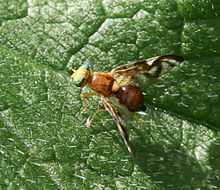Euleia heraclei
From Wikipedia, the free encyclopedia

Group of Euleia heraclei mating
| Euleia heraclei | |
|---|---|
 | |
| Scientific classification | |
| Kingdom: | Animalia |
| Phylum: | Arthropoda |
| Class: | Insecta |
| Order: | Diptera |
| Section: | Schizophora |
| Subsection: | Acalyptratae |
| Superfamily: | Tephritoidea |
| Family: | Tephritidae |
| Genus: | Euleia |
| Species: | E. heraclei |
| Binomial name | |
| Euleia heraclei | |
Euleia heraclei, known as the Celery fly or the Hogweed picture-wing fly is a species of tephritid or fruit flies in the genus Euleia of the family Tephritidae.[1][2]
It is found on Hogweed (hence its specific name)[3] and is a pest of celery and parsnips, where it damages the vegetables by leaf mining.[4] The species is dimorphic in that its body can be either black or else orange-brown.[5]
The males display on the upper surfaces of leaves on sunny days during May. Mating takes place when a female arrives (pictured). In Britain, the species is distributed widely across southern and central England; in Wales records are mainly near the coast.[6]
References
- ↑ Nomen.at: Euleia
- ↑ GBIF species
- ↑ "Euleia heraclei". Retrieved 18 May 2012.
- ↑ "Celery Fly". Nature Spot. 2012. Retrieved 18 May 2012.
- ↑ Carroll, L.E., I.M. White, A. Freidberg, A.L. Norrbom, M.J. Dallwitz, and F.C. Thompson (2002 onwards (2006)). "Pest Fruit Flies of the World". Retrieved 18 May 2012. (Detailed description of fly, no ecology)
- ↑ "Grid map of records on the Gateway for Euleia heraclei". National Biodiversity Network. 2012. Retrieved May 18, 2012.
This article is issued from Wikipedia. The text is available under the Creative Commons Attribution/Share Alike; additional terms may apply for the media files.